 |
|
|
| (Information by Peter Kessler, with additional information from The Philistines and Other 'Sea Peoples' in Text and Archaeology, Ann E Killebrew (Society of Biblical Literature Archaeology and Biblical Studies, 2013), from The Histories, Herodotus (Penguin, 1996), from The Iliad, Homer (Translated by E V Rieu, Penguin Books, 1963), from The Kingdom of the Hittites, Trevor Bryce (1998), from The Hittites, O R Gurney (1991), from Trojans and Their Neighbours: An Introduction (Ancient Peoples), Trevor Bryce (2005), from the Argonautica, Apollonius Rhodius (3rd century BC Greek epic poem), from The Horse, the Wheel, and Language: How Bronze-Age Riders from the Eurasian Steppes Shaped the Modern World, David W Anthony, and from External Links: the Dictionary of Greek and Roman Geography, William Smith (Ed, 1854), and DNA clue to origins of early Greek civilisation (BBC News), and Geography, Strabo (H C Hamilton & W Falconer, London, 1903, Perseus Online Edition), and The Greeks really do have near-mythical origins, ancient DNA reveals (Science). |
|
|
| 31st-26th cent BC |
Troy first appears to be occupied as a permanent settlement around the thirty-first century BC (3600 BC is given as a date of initial settlement without a town being built, labelled Troy 0). Each subsequent rebuilding of that settlement leaves an archaeological layer. 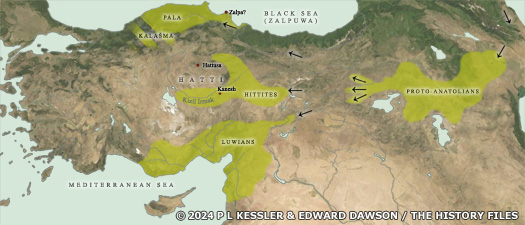 This map attempts to illustrate in basic terms the separate paths taken by the Luwians, Hittites, and Pala during their westwards migration and their progress from proto-Anatolians to kingdom-builders (click or tap on map to view full sized) This map attempts to illustrate in basic terms the separate paths taken by the Luwians, Hittites, and Pala during their westwards migration and their progress from proto-Anatolians to kingdom-builders (click or tap on map to view full sized) |
|
| The first four layers are built and are subsequently abandoned or destroyed by the twentieth century BC. Troy I is relatively basic - mud brick houses and a thick rubblework wall are later described in archaeological works. The city is eventually destroyed by fire. This settlement has been founded by very recently-arrived proto-Anatolians, close South Indo-European relatives of their fellow migrants in Anatolia, the Luwians, Hittites, and Pala, all of whom are slightly less closely related to the proto-Indo-Europeans of the Pontic-Caspian steppe. The ancestors of these proto-Anatolians may first have demonstrated their migratory skills as part of the Suvorovo culture of a millennium previously, although the precise nature of the spread of Luwian-speakers is not clearly understood. |
|
|
| 26th-23rd cent BC |
Troy II shows the same signs of trade with Sumer and increasingly sophisticated artwork which also characterises the cities of the Hatti during the same period between 2500-2200 BC. It contains extended towered walls and royal treasure. Partially burned by fire, the same city is rebuilt with a more dense street plan. It ends with another 'burnt city' layer though. 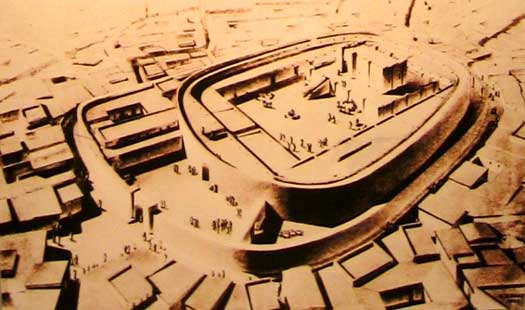 This reconstruction of a Sumerian temple provides some idea of how such religious buildings would have connected with the city around them This reconstruction of a Sumerian temple provides some idea of how such religious buildings would have connected with the city around them |
|
| c.2200 BC |
Local art in Hatti (as well as at Troy), while still primitive, has already achieved a level of stylisation in the region which is independent of Sumerian influences, and metalwork is elaborately decorated, as discovered in the royal tombs of Alaca Höyük. However, this point seems to mark the end of a period of success, and the end of this cultural period, as shown by a layer of destruction and the burning of the Hatti citadel (part of a decline which is seen across the entire region, including at Tuba in Syria, Eridu and [Uruk](MesopotamiaUruk.htm#Fourth Dynasty) in Sumer, [ Egypt](../KingListsAfrica/EgyptAncient.htm#1st Intermediate Period), and also at Troy). |
|
| 23rd-21st cent BC |
Troy III is dominated by stone houses, although archaeological data is scarce due to Schliemann's excavation practices. This Troy is sacked and burned around the mid-twenty-first century BC. Probably not a coincidence, this is close to the end of a period of renewed prosperity which gives way to the Hattian Middle Period in the cities of the Hatti. 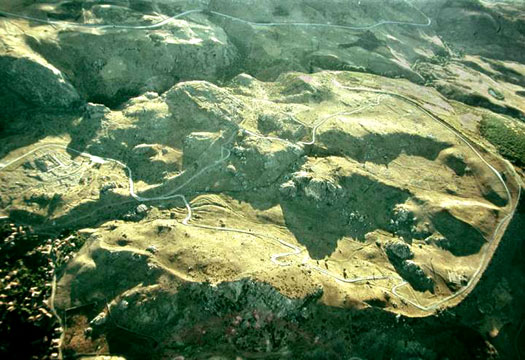 The Hittite 'Old City' (which was probably based on the ruins of the Hatti city) comprised an area of almost one square kilometre, being protected by a massive fortification wall while on the high ridge of Büyükkale was the residence of the 'Great King', and the city lay on the slope below to the north-west, reaching towards the valley below The Hittite 'Old City' (which was probably based on the ruins of the Hatti city) comprised an area of almost one square kilometre, being protected by a massive fortification wall while on the high ridge of Büyükkale was the residence of the 'Great King', and the city lay on the slope below to the north-west, reaching towards the valley below |
|
| 21st-20th cent BC |
Troy IV is rebuilt from the ashes with a citadel which covers four acres and mud-brick houses which feature domed ovens. The cause of destruction for this layer just a century or so later is unknown. There is no corresponding break in progress in the cities of the Hatti so perhaps the cause this time is much more localised in nature. |
|
| 20th-19th cent BC |
The houses in Troy V are larger than before and evidence from the site suggests a greater level of sophistication in pottery production methods. This layer is contemporaneous with the Hatti city states in central Anatolia and that of Zalpa to the north immediately prior to the arrival of the Hittites. The region is probably also settled by Luwians from Arzawa by this time. |
|
| 17th-15th cent BC |
Troy VI is in use in this period. According to tradition, the state of Troy is built up in this period by the Teucri and Dardanians (although the later use of 'Teucrian' to refer to Trojans is mistaken). The state grows to dominate the Dardanelles, the north-western corner of Anatolia, and areas in the Balkans. A Luwian Arzawan inscription found here is dated to this period, but whether or not the Trojans themselves are Luwian-speakers is uncertain. 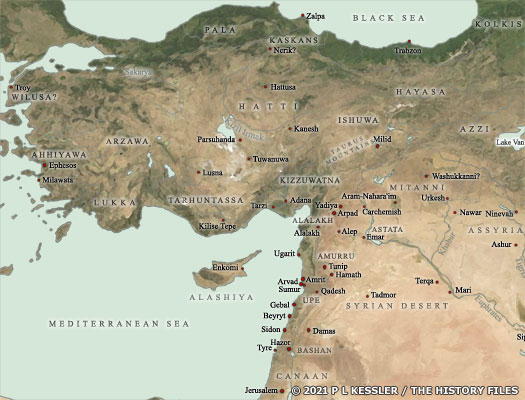 A short dark age had followed the Hittite collapse around 1500 BC, but a much greater one awaited the regional social and political collapse at the end of the thirteenth century BC (click or tap on map to view full sized) A short dark age had followed the Hittite collapse around 1500 BC, but a much greater one awaited the regional social and political collapse at the end of the thirteenth century BC (click or tap on map to view full sized) |
|
| The Hittites claim in their later treaty with Alaksandu of Wilusa (see circa 1280 BC, below) that ties of friendship between the two states date from this period, under the reign of Hattusili I. |
|
|
| 1600 - 1400s BC |
Traditional rulers are shown here in green with a green-tinted background in order to clearly differentiate them, while their historical counterparts are shown normally. |
|
| c.1400 - 1300 BC |
The Troy VIh subdivision layer is in use until it is destroyed by an earthquake around 1300 BC. If Troy is indeed Wilusa, then it is this city which borders Mira, a division of Arzawa to its south-east. In the period between 1380-1370 BC, when the Hittite king Tudhaliya IV (III) invades Arzawa, he does not enter Wilusa because the state is a member of the Assuwa (or Assua), a confederacy of local minor states (probably including the states of the Troad) which has traditionally been allied to the Hittites.  This word, Assuwa, is claimed as the original form of 'Asia' as used by the ancient Greeks to denote Anatolia (see feature link for a detailed examination of this label). This word, Assuwa, is claimed as the original form of 'Asia' as used by the ancient Greeks to denote Anatolia (see feature link for a detailed examination of this label). 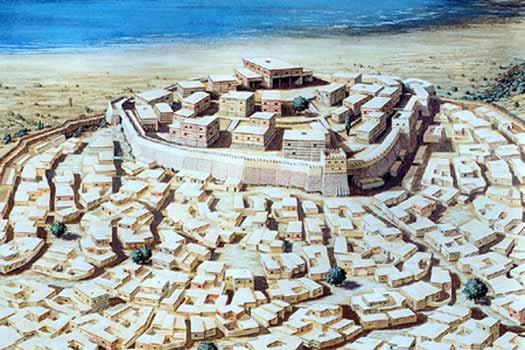 Shown here is an artist's impression of Troy VIh/VIi around 1400 BC, although only the citadel has been excavated properly, with much of the rest of the city's footprint lying beneath mud and still waiting to be rediscovered Shown here is an artist's impression of Troy VIh/VIi around 1400 BC, although only the citadel has been excavated properly, with much of the rest of the city's footprint lying beneath mud and still waiting to be rediscovered |
|
| c.1375 - 1315 BC |
Tros |
Also ruler of the Dardanians. |
| c.1315 BC |
Tros leaves Troy to one of his sons, Ilos (who marries Eurydice), while the other, Assaracus, rules Dardania. Ilos is credited with founding the royal line of Ilium (or Ilios, a Greek name which equates to the Hittite (W)ilios / Wilusa). |
|
| fl c.1330s BC |
Kikunni / Kukunni |
Ally of Hittite King Suppiluliuma I. Murdered. |
| c.1315 - 1260 BC |
Ilos / Ilus |
Son of Tros. Source of the Hittite 'Wilusa' or a construct? |
| c.1300 - 1183 BC |
Troy VIIa is in use following the earthquake which destroys the VIh city. This is the most likely candidate for Homer's large city which is sacked at the end of the Trojan War, and is also believed to correspond with the Hittite Wilusa of roughly 1330-1245 BC. It is mainly a rebuilding of elements from the previous layer and the city shows signs of rationing, but may recover and expand from this. Using Classical dating, the city walls are constructed (by Poseidon, Apollo, and Aeacus) in 1282 BC (this could be rebuilding work which is undertaken by Alaksandu around the 1280s BC). 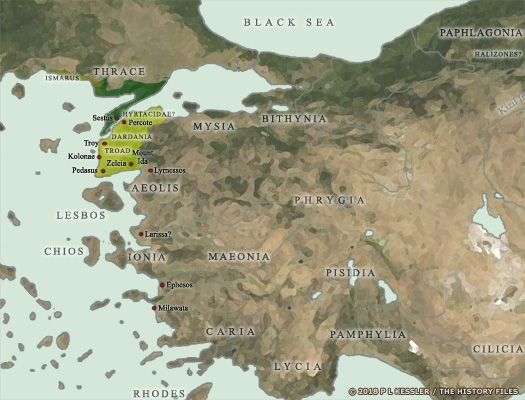 This map of Anatolia is set at the time of the Trojan War, covering the general area of Dardania and the Troad (click or tap on map to view full sized) This map of Anatolia is set at the time of the Trojan War, covering the general area of Dardania and the Troad (click or tap on map to view full sized) |
|
| fl 1295 - 1280? BC |
Piyama-Radu / Piyamaradu |
A king of Arzawa? Fled to Ahhiyawa? Same as Priam? |
Piyamaradu is a renegade (or adventurer) who seizes the throne in Wilusa after slaying the king, possibly launching his bid from Arzawa. According to Hittite texts he has the help of Ahhiyawa. He is mention around 1295 BC and 1250 BC, and again in the past tense around 1245 BC. It may be the case that he seizes Wilusa around 1295 BC, is overthrown by the Hittites and replaced by Alaksandu (who himself is not necessarily a blood relative of Kikunni's), and ends up in Miletus where he is aided by the brother of the king of Ahhiyawa. Despite his name being similar to that of the Priam of Greek legend, his career sounds very different, so the link between the two which some scholars favour seems doubtful. 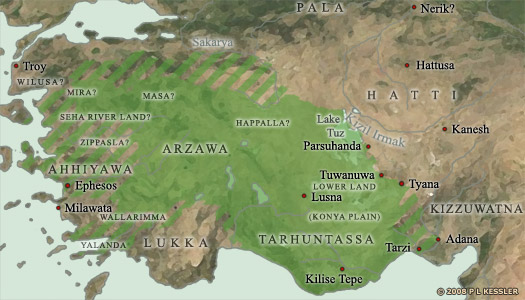 The state of Arzawa existed from at least 1650 BC. By around 1450 BC it controlled the solid green section of the map, which included the state of Tarhuntassa, but probably not the 'Lower Land' (click or tap on map to view full sized) The state of Arzawa existed from at least 1650 BC. By around 1450 BC it controlled the solid green section of the map, which included the state of Tarhuntassa, but probably not the 'Lower Land' (click or tap on map to view full sized) |
|
|
| There is also a possibility that the real Trojan War is this fight between the Hittites and Piyama-Radu. Homer's build-up to the fall of Troy includes various events in western Anatolia which could also be attributed to a Hittite campaign. The timeframe for this theory fits better with Piyama-Radu being Priam, and his being succeeded by Alexander (Paris). The arrival of Mycenaeans on the coast could be a confusion with later migrations (after 1200 BC) which perhaps have to fight coastal Anatolians to be able to secure a foothold. Later generations possibly merge the two events before Homer's treatment of them. |
|
|
| fl c.1280 BC |
Aleksandu of Wilusa |
Ally of Hittite King Muwatalli II. Same as Paris Alexandros? |
| c.1280 BC |
At Mira in Arzawa, Kupanta-Kurunta, the adopted son of the Hittite King Muwatalli's aunt, is considered to be a Hittite family member so Alexandros is duty-bound to help Kupanta-Kurunta even against his own people if need be. The Arzawan state of Masa (on the south-eastern border of Wilusa's territory) attacks Alexandros and is destroyed (again) by Muwatalli who already has a treaty agreement with Aleksandu. 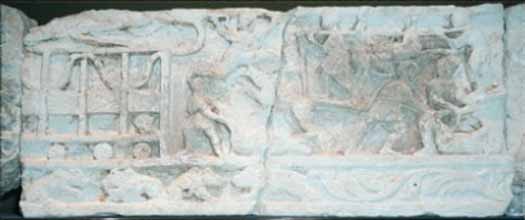 This Hittite tablet mentions the kingdom of Arzawa, although generally the Anatolian kingdom is little-known and barely mentioned in the historical record This Hittite tablet mentions the kingdom of Arzawa, although generally the Anatolian kingdom is little-known and barely mentioned in the historical record |
|
| c.1290/1250 BC |
Walmu / Wilmu of Wilusa |
Restored by the Hittite King Muwatalli II or Tudhaliya V (IV). |
| c.1260 - 1224 BC |
Laomedon |
Son of Illos. Dau m Cygnus of Kolonae. |
Otreus, son of Daskylos, king of Mysia, is killed by Amykos, king of Bithynia, whilst travelling to Troy to sue for the hand in marriage of King Laomedon's daughter, Hesione. The Mysians would appear to be recent arrivals in the region, and are no doubt attempting to cement their position. Laomedon is claimed by Greek literature to be the father of Tithonus, who himself is later a lover of Eos, goddess of the dawn. Eos bears Tithonus two sons, Memnon and Emathion, while Tithonus is claimed to be the founder of Susa after travelling east into [through] Assyria. In fact, Susa is already an ancient city of [Elam](EasternElam.htm#Shutrukid Kings). Memnon, 'son of [the] dawn', apparently forms an overseas colony, claimed to be Ethiopia but more probably much closer to Troy, who brings his forces to Troy's assistance during the Trojan War. 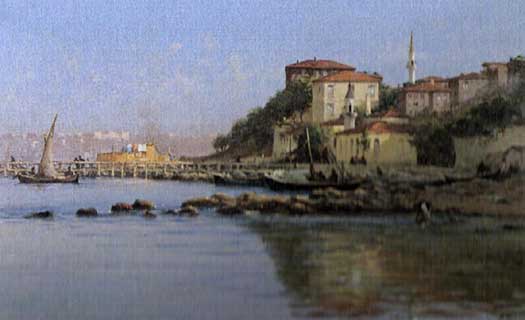 With the collapse of the Hittites at the end of the thirteenth century BC, the Sea of Marmara suddenly became a frontier with the aggressive Greek city states on its far side, although this early twentieth century painting by Fausto Zonaro makes it look peaceful With the collapse of the Hittites at the end of the thirteenth century BC, the Sea of Marmara suddenly became a frontier with the aggressive Greek city states on its far side, although this early twentieth century painting by Fausto Zonaro makes it look peaceful |
|
|
| c.1224 - 1183 BC |
Priam / Podarces |
Son. Same as Piyama-Radu? |
| c.1200 BC |
Wilusa's traditional ally, the Hittites, are destroyed around this time, as are the Arzawan lands to the south-east, and general instability grips the Eastern Mediterranean coast. The state probably finds itself very much alone in this period, with just its local allies for support. Later Greeks date the Trojan War as follows: Eratosthenes to 1184/83 BC, the Parian Marble to 1209/08 BC, Herodotus to about 1250 BC, and Douris to 1334/03 BC. Herodotus' dates have been adjusted downwards by eighty-seven years to bring them into line with the timeframe used here for the Trojan War: about 1193-1183 BC. |
|
| c.1193 - 1183 BC |
As detailed in Homer's Iliad, Agamemnon of Mycenae amasses the forces of his allied Achaean kingdoms and sails from Greece, determined to attack Troy. In response, Troy gathers together its own allies, including those of Dardania, the Halizones, the Hyrtacidae, Karkissa, Kolonae, Larissa, Lycia, [Maeonia](AnatoliaLydia.htm#Atyad Maeonia), Mysia, Paphlagonia, Percote, Phrygia, Thrace, and Zeleia, along with the Leleges, and also Pelasgians from several locations in western Anatolia (and especially from the Troad region around Troy itself). 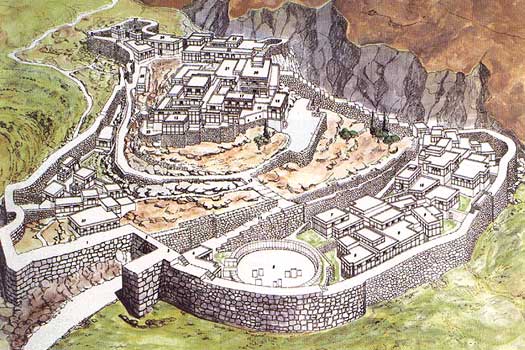 This artist's reconstruction of the citadel at Mycenae shows it at the height of its power, when Mycenaean Greeks ruled or terrorised much of the eastern Mediterranean Sea This artist's reconstruction of the citadel at Mycenae shows it at the height of its power, when Mycenaean Greeks ruled or terrorised much of the eastern Mediterranean Sea |
|
All of these disparate units are commanded by Hector and Paris of Troy. The allied contingents speak a multitude of languages, so orders have to be translated by each contingent's commander. Nine years of regional sparring take place which include the sacking of Lyrnessos and the loss to Troy of this city's troops. Then the Achaeans beach their ships in the final year of the conflict and set up camp near the mouth of the River Scamander (modern Karamenderes, five kilometres further inland than today, pouring into a bay). The city of Troy itself stands on a hill, across the plain of Scamander, which is where the battles of the Trojan War take place. After fighting to a stalemate, the Mycenaeans apparently use trickery to finally enter and sack Troy. The son of Achilles of Phthia kills Priam and takes Andromache, the widow of Hector, as his concubine. He also takes Elenos, a son of Priam, as a slave when he travels to northern Greece to found the kingdom of Epirus. Chaon, brother or friend of Elenos, goes with them. The rest of the invaders also carry off slaves and booty. On the Trojan side, Aeneas manages to escape the destruction and, with his Dardanian followers (along with Nisus of the Hyrtacidae), eventually settles in Latium, while the Elymi of Sicily are also claimed as Trojans. 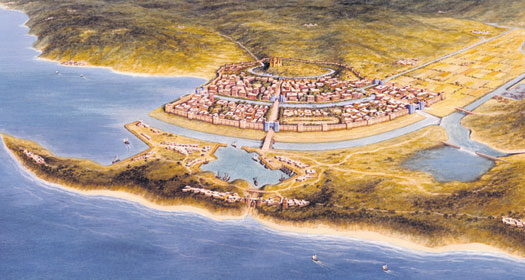 This illustration is another artist's impression of an unspecified version of Troy, although it is believed to be based on the city which existed around the time of the Trojan War, shortly before its defeat and destruction This illustration is another artist's impression of an unspecified version of Troy, although it is believed to be based on the city which existed around the time of the Trojan War, shortly before its defeat and destruction |
|
|
| The single, ten year war is probably Homer's collecting together of an ongoing conflict, as at one point a Hittite letter to a Mycenaean king briefly waves aside the Wilusa 'problem' and states that the two kings are friends again. |
|
|
| 1183 BC |
Paris (Alexandros) |
Son. Mortally wounded by Philoctetes. |
| 1183 BC |
Deiphobus |
Brother. m Helen but killed by Menelaus. |
| Later Greek myths (from the sixth century) say that Helen spends the duration of the Trojan War in [ Egypt](../KingListsAfrica/EgyptAncient.htm#19th Dynasty) rather than Troy, and that after the war the Mycenaeans go there to recover her and are identified by the Egyptians as Sea Peoples. |
|
|
| c.1183 - 1120 BC |
Troy VIIb1 is in use as a smaller settlement which has to be rebuilt out of the ruins of the 'great' Troy of the wars, probably by a mixture of surviving natives and Mycenaean settlers. Mycenaeans have already been settled near, and in, Troy since before the Trojan War (probably traders for the most part), as evidenced by the Greek cemetery which is uncovered at Troy by archaeologists in the twentieth century. This Troy is destroyed by fire. 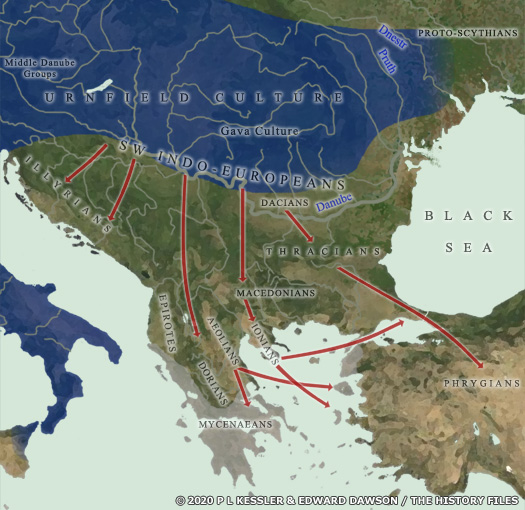 Climate-induced drought in the thirteenth century BC created great instability in the entire eastern Mediterranean region, resulting in mass migration in the Balkans, as well as the fall of city states and kingdoms further east (click or tap on map to view full sized) Climate-induced drought in the thirteenth century BC created great instability in the entire eastern Mediterranean region, resulting in mass migration in the Balkans, as well as the fall of city states and kingdoms further east (click or tap on map to view full sized) |
|
| c.1120 - 1020 BC |
Troy VIIb2 is in use, but the building style is dramatically different from earlier phases. It has been suggested that the changes are due to Phrygian influence which also appear at Gordion. This city is apparently destroyed by fire, possibly linked to an earthquake. |
|
| c.1000 - 950 BC |
Troy VIIb3 is in use, but with little original building work or grandeur, as befits a cultural and political dark age across the Near East for the best part of three centuries after the collapse of about 1200 BC. Early Classical Greek influence can be seen, but not necessarily Greek settlement amongst the natives. This city is largely deserted by around 950 BC following another fire. The site remains generally - but not fully - uninhabited for about two centuries. |
|
| fl c.700 - 85 BC |
Troy VIII is in use again, with building work being of a Greek nature and reusing some defensive elements of Troy VI (so it is clearly not a well-funded development). Again the city is partially abandoned, remaining a very minor site into the Greek Classical period. It is destroyed in favour of the newly-built Troy IX. 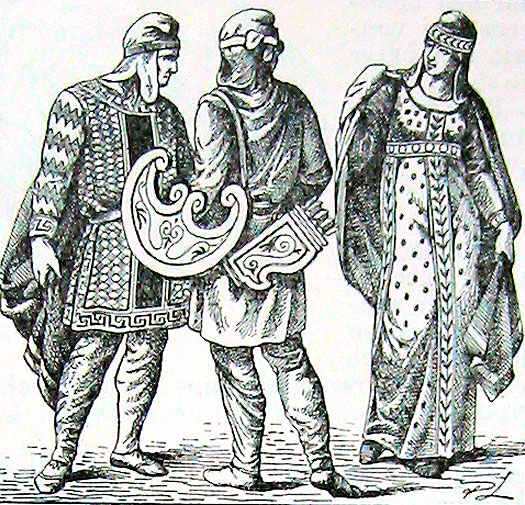 This relatively recent view shows Phrygian costume at the height of the later kingdom's power, as attested by surviving visual records, especially of the peaked cap This relatively recent view shows Phrygian costume at the height of the later kingdom's power, as attested by surviving visual records, especially of the peaked cap |
|
| 20s BC |
Hellenistic Troy IX is founded by Rome and remains an important trading city until Emperor Constantine 'the Great' establishes his new city of Constantinople. Under Eastern Roman rule the city gradually declines and eventually disappears, especially following earthquakes around AD 500. |
|
 |
|
|

 This map attempts to illustrate in basic terms the separate paths taken by the Luwians, Hittites, and Pala during their westwards migration and their progress from proto-Anatolians to kingdom-builders (click or tap on map to view full sized)
This map attempts to illustrate in basic terms the separate paths taken by the Luwians, Hittites, and Pala during their westwards migration and their progress from proto-Anatolians to kingdom-builders (click or tap on map to view full sized) This reconstruction of a Sumerian temple provides some idea of how such religious buildings would have connected with the city around them
This reconstruction of a Sumerian temple provides some idea of how such religious buildings would have connected with the city around them The Hittite 'Old City' (which was probably based on the ruins of the Hatti city) comprised an area of almost one square kilometre, being protected by a massive fortification wall while on the high ridge of Büyükkale was the residence of the 'Great King', and the city lay on the slope below to the north-west, reaching towards the valley below
The Hittite 'Old City' (which was probably based on the ruins of the Hatti city) comprised an area of almost one square kilometre, being protected by a massive fortification wall while on the high ridge of Büyükkale was the residence of the 'Great King', and the city lay on the slope below to the north-west, reaching towards the valley below A short dark age had followed the Hittite collapse around 1500 BC, but a much greater one awaited the regional social and political collapse at the end of the thirteenth century BC (click or tap on map to view full sized)
A short dark age had followed the Hittite collapse around 1500 BC, but a much greater one awaited the regional social and political collapse at the end of the thirteenth century BC (click or tap on map to view full sized) This word, Assuwa, is claimed as the original form of 'Asia' as used by the ancient Greeks to denote Anatolia (see feature link for a detailed examination of this label).
This word, Assuwa, is claimed as the original form of 'Asia' as used by the ancient Greeks to denote Anatolia (see feature link for a detailed examination of this label).  Shown here is an artist's impression of Troy VIh/VIi around 1400 BC, although only the citadel has been excavated properly, with much of the rest of the city's footprint lying beneath mud and still waiting to be rediscovered
Shown here is an artist's impression of Troy VIh/VIi around 1400 BC, although only the citadel has been excavated properly, with much of the rest of the city's footprint lying beneath mud and still waiting to be rediscovered This map of Anatolia is set at the time of the Trojan War, covering the general area of Dardania and the Troad (click or tap on map to view full sized)
This map of Anatolia is set at the time of the Trojan War, covering the general area of Dardania and the Troad (click or tap on map to view full sized) The state of Arzawa existed from at least 1650 BC. By around 1450 BC it controlled the solid green section of the map, which included the state of Tarhuntassa, but probably not the 'Lower Land' (click or tap on map to view full sized)
The state of Arzawa existed from at least 1650 BC. By around 1450 BC it controlled the solid green section of the map, which included the state of Tarhuntassa, but probably not the 'Lower Land' (click or tap on map to view full sized) This Hittite tablet mentions the kingdom of Arzawa, although generally the Anatolian kingdom is little-known and barely mentioned in the historical record
This Hittite tablet mentions the kingdom of Arzawa, although generally the Anatolian kingdom is little-known and barely mentioned in the historical record With the collapse of the Hittites at the end of the thirteenth century BC, the Sea of Marmara suddenly became a frontier with the aggressive Greek city states on its far side, although this early twentieth century painting by Fausto Zonaro makes it look peaceful
With the collapse of the Hittites at the end of the thirteenth century BC, the Sea of Marmara suddenly became a frontier with the aggressive Greek city states on its far side, although this early twentieth century painting by Fausto Zonaro makes it look peaceful This artist's reconstruction of the citadel at Mycenae shows it at the height of its power, when Mycenaean Greeks ruled or terrorised much of the eastern Mediterranean Sea
This artist's reconstruction of the citadel at Mycenae shows it at the height of its power, when Mycenaean Greeks ruled or terrorised much of the eastern Mediterranean Sea This illustration is another artist's impression of an unspecified version of Troy, although it is believed to be based on the city which existed around the time of the Trojan War, shortly before its defeat and destruction
This illustration is another artist's impression of an unspecified version of Troy, although it is believed to be based on the city which existed around the time of the Trojan War, shortly before its defeat and destruction Climate-induced drought in the thirteenth century BC created great instability in the entire eastern Mediterranean region, resulting in mass migration in the Balkans, as well as the fall of city states and kingdoms further east (click or tap on map to view full sized)
Climate-induced drought in the thirteenth century BC created great instability in the entire eastern Mediterranean region, resulting in mass migration in the Balkans, as well as the fall of city states and kingdoms further east (click or tap on map to view full sized) This relatively recent view shows Phrygian costume at the height of the later kingdom's power, as attested by surviving visual records, especially of the peaked cap
This relatively recent view shows Phrygian costume at the height of the later kingdom's power, as attested by surviving visual records, especially of the peaked cap